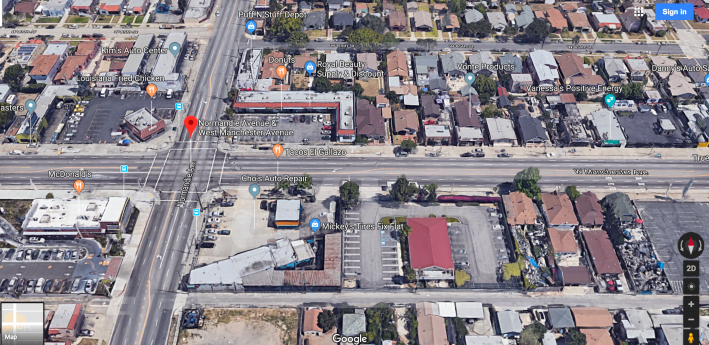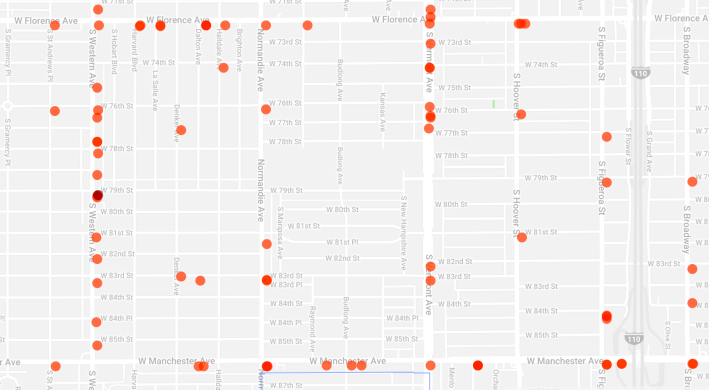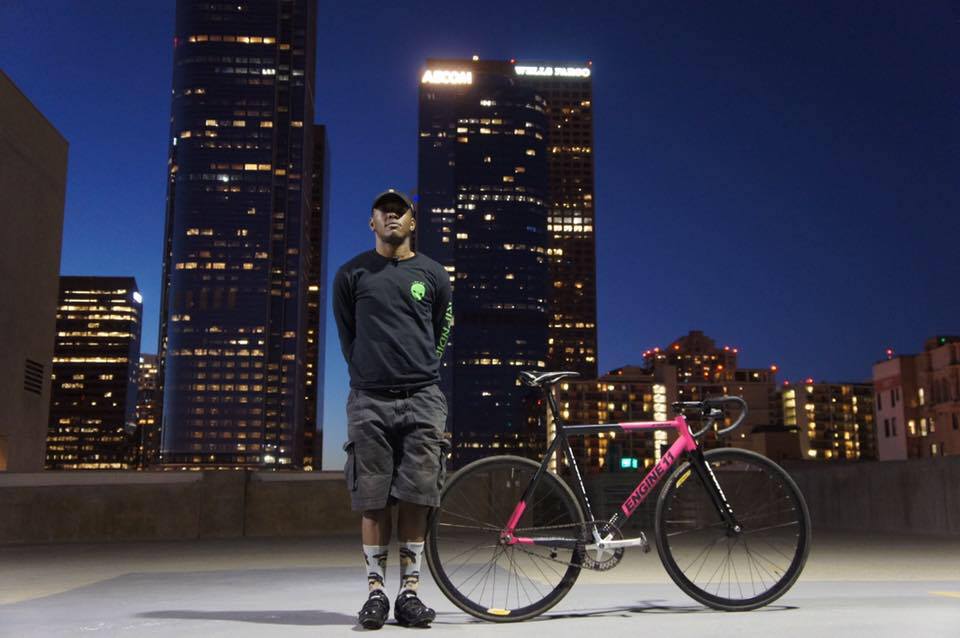In one of several haunting images of the aftermath of the hit-and-run at Manchester and Normandie that killed 22-year-old cyclist and area resident Frederick Frazier - "Woon," to friends - yesterday afternoon, a concerned man stands over Frazier's splayed and twisted body.
His hand, gently cradling Frazier's muscular shoulder, indicates both an attempt to offer comfort and an effort to discern the felled young man's chances for survival.
The rest of the scene provides the devastating answers.
Frazier was hit hard and fast from behind just blocks from his home.
His bike lies broken - the back end cleanly snapped off - some twenty-five feet back from where its rider came to rest. The handlebars are missing - likely torn off as the bike flipped and smashed into the ground at high speed. Ten or fifteen feet ahead and to the left of Frazier lie what appear to be the mangled remains of the back wheel intertwined with whatever was torn out from underneath the white Porsche Cayenne SUV that police believe caused this terrible mayhem.

The fact that the debris sits squarely in the adjacent lane suggests the driver probably watched the youth slam into the concrete and still decided the best course of action was to quickly switch lanes and maneuver around his body.
It's an incredible thing to contemplate, especially considering the driver must have had some awareness of the severity of the damage done: the skin torn off Frazier's forearms; the powerful limbs wildly flung askew; a helmet resting quietly in a pool of blood - no match for the force with which Frazier's head hit the ground; a mouth frozen open, as if in a silent, tortured scream.
A final image taken at the scene shows Frazier being moved into an ambulance, leaving only the pool of blood and the towel paramedics had slipped under his head to testify to both the abrupt arbitrariness with which a young life can be snatched and the heartbreak such hideous disregard for human life leaves in its wake.
The images of Frazier's body were removed from social media some time overnight - taken down by the area cyclist that had first posted them in the effort to identify the young man he prayed was still alive.
In the few short hours the images were up, however, they sent a collective shockwave through the cycling community as riders scrambled to figure out who within their ranks had been so brutally run down. They also provoked the inevitable involuntary shudders at memories of all the times vehicles had cut too close, of car doors opening unexpectedly, of being blindsided by a driver's sharp left or fast right hook, of being threatened with harm by a driver who felt inconvenienced, or of a friend or another member of the community who had been lost.
The images were also a sobering reminder of how terrifyingly fragile the human body is when confronted by a multi-ton vehicle traveling at just about any speed.

Frazier was not inexperienced on the road.
Friend and fellow cyclist Cortez Wright remembers him as goofy and always cracking jokes, but also as someone who had been riding for almost a decade. Frazier inspired him to train harder in order to be able to beat him in races, Wright says, but Frazier was always too powerful, too strong.
Even for the strongest among us, however, mortality is ever-present.
Few cyclists part ways without telling each other to "ride safe!" even if they know it often isn't up to them whether or not they make it home.
Poor street design, the privileging of speedy passage, limited pedestrian and cycling infrastructure (particularly in communities like South L.A.), and the continued hostility of Angelenos to any efforts to make L.A.'s streets more welcoming for all road users play an outsized role in determining whether a cyclist's ride is "safe."

Manchester Avenue, like many of South Central's wide east-west corridors, moves very fast. The combination of the mix of industry, commerce, and residences that line the street and the fact that Manchester is one of the few corridors cutting across the whole of South L.A. (and connecting it to Inglewood) means that it is heavily traversed by massive trucks, buses, and personal vehicles alike. It has too few crosswalks and too few stoplights. And even at intersections with smaller cross streets where there are stoplights (e.g. McKinley), a pedestrian or cyclist will wait several minutes before the traffic gods finally heed the cries of the pedestrian beg buttons and grant them passage.
It is abundantly clear who the street privileges, in other words.
So much so that the fact that Manchester has fewer fatal collisions involving pedestrians and cyclists than its north-south counterparts (like Western or Vermont) serves as a better indicator of how much more likely pedestrians and cyclists are to try to avoid it than it does as evidence that it is safer.

Even with this young man's murder added to the dozen-plus others L.A.'s streets have racked up this year, it is unlikely that much will change on the ground. The deafening uproar over the appearance of safety improvements in Playa del Rey last year handily dampened elected officials' already limited enthusiasm for trying to slow L.A. down in order to make it more multi-modal.
Sadly, it's vulnerable road users like Frazier who will continue to pay for that stasis.
And those same vulnerable road users will continue to have few methods by which they can carve out a safe space for themselves in the streets.
Galvanized by the photos of their homie lying broken in the street, Frazier's friends chose to claim space by corking the intersection at Normandie just a few hours ago.
#BREAKING Pedestrian struck while protesting fatal cyclist crash in South LA; driver flees scenehttps://t.co/lofYIF004B pic.twitter.com/KlaoXNblaP
— ABC7 Eyewitness News (@ABC7) April 11, 2018
The riders had first gathered on Normandie to pay their respects to the family and then headed north to the site where their friend was mowed down.
A driver and her female passenger in an early-2000s gold Toyota Avalon, unhappy at being inconvenienced by the mourners circling and chanting "Long live Woon!," slowly moved their car into the intersection. After exchanging words with some of the cyclists, the female passenger exited the vehicle and got into a physical altercation with a female cyclist - punching or slapping her. The passenger then returned to the car, which then exited the intersection.
When a squad car arrived to move the mourners along, some did so reluctantly but most refused to go. A handful of the mourners began pounding on the police car - a few swung at it with their bicycles.
At some point during this time, the driver of the gold Toyota Avalon returned to the intersection, apparently for the sole purpose of doing harm. As the police vehicle moved to one end of the intersection, the gold vehicle sped through the intersection on a red light, slamming into one of the mourners and flipping him into the air (below).
And it all happened in front of news crews, police, and more than one hundred witnesses.
The stunned cyclists immediately gave chase.
The victim, Quatrell Stallings, was taken to the hospital but was taken to the hospital. He suffered head trauma, has a broken ankle and leg, and will need to have surgery on his knee, according to ABC7.
"I feel distraught right now," Stallings told ABC7. "I know my friend Woon wouldn't want that to happen. I came with nothing but all peace and positivity. It was all for him."
The driver of the car sporting license plate number 8BUK639 and a partially shattered windshield has yet to be found.
The city is offering a $50,000 reward for help in identifying the person responsible for the hit-and-run that killed Frazier. If you have any information, you are encouraged to call South L.A. Traffic at 323-421-2500. A memorial ride will be held for him on Friday. Details can be found here.
This post was updated at 8 p.m. on April 11 to reflect new information regarding the second hit-and-run incident at the intersection. It was again updated at 12:13 p.m. and 5:09 p.m. on April 12, and then again on April 13 at 8:56 a.m. to include further details as they became available.







